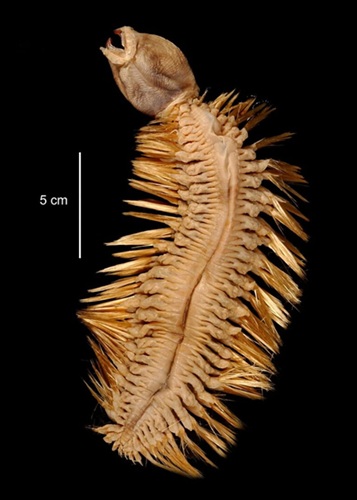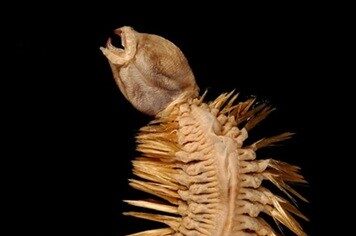
The Secret Behind Its Golden Glow
One of the most distinctive features of Eulagisca gigantea is its shimmering golden bristles. These metallic-looking spines catch the light beautifully and have become the worm’s most famous characteristic. Scientists believe these bristles may help the worm move across the seafloor, sense vibrations in the water, or even protect it from predators. Some experts suggest the reflective quality might serve as camouflage by blending with light reflections underwater.
Though it might appear menacing, this creature plays a crucial role in its ecosystem. Deep-sea worms like Eulagisca gigantea contribute to nutrient recycling and help maintain the delicate balance of Antarctic marine life. By breaking down organic material and serving as prey for other species, they are an essential part of the ocean’s food web.
Part of a Hidden World Beneath the Waves
Eulagisca gigantea is part of a vast and diverse group of segmented worms known as polychaetes. With more than 8,000 known species — and possibly thousands more yet to be discovered — polychaetes can be found in nearly every marine habitat on Earth, from shallow reefs to the deepest ocean trenches.
These worms come in all shapes and colors, and many of them display extraordinary adaptations to survive in extreme conditions. In fact, scientists estimate that only about half of all marine worm species have been officially documented so far. This means the ocean could be home to countless other bizarre and beautiful creatures just waiting to be found.
From Deep Sea to Digital Fame
The renewed fascination with Eulagisca gigantea began when a photo of the worm surfaced on Facebook, showing off its glittering golden bristles and sharp, fang-like mouth. The image quickly spread across social media platforms, sparking thousands of reactions. Viewers were divided between awe and disbelief — some marveled at its alien beauty, while others jokingly said it looked like something from a horror movie.
But this viral moment did more than just entertain. It reminded people of how little we truly know about the deep sea. Despite being the largest habitat on Earth, more than 80% of the ocean remains unexplored. Every discovery — from glowing jellyfish to armored worms like Eulagisca gigantea — brings us closer to understanding the incredible diversity of life that thrives far beneath the waves.
The Importance of Protecting the Deep
Beyond its viral fame, Eulagisca gigantea serves as a symbol of how fragile and fascinating the ocean ecosystem truly is. Antarctica’s marine habitats are among the most pristine and least disturbed on the planet, but they are increasingly at risk from climate change and human activity. Rising temperatures and shifting ocean currents can have unpredictable effects on these deep-sea species that depend on stable conditions to survive.
Preserving these environments is essential — not only to protect unique creatures like Eulagisca gigantea but also to safeguard the health of our planet’s oceans as a whole. The deep sea remains one of Earth’s final frontiers, holding secrets that could help us understand evolution, adaptation, and even the origins of life itself.
As new technologies such as deep-sea submersibles and remotely operated vehicles (ROVs) continue to push the boundaries of exploration, scientists are confident that even more astonishing species will soon be revealed. Some may look frightening, others breathtakingly beautiful — but all will deepen our appreciation for the wonders hidden beneath the waves.
A Window Into the Unknown
The story of Eulagisca gigantea isn’t just about one fascinating worm — it’s about curiosity, discovery, and the unending mysteries of the natural world. Each new creature we encounter in the deep sea challenges our understanding of life and reminds us of how much there is still to learn.
So, the next time a strange sea creature pops up in your social media feed, take a moment to appreciate it. Behind every viral photo is a glimpse into an unexplored world — one that’s still full of secrets, beauty, and incredible resilience.
Would you dare to explore the deep sea and see creatures like this up close? Share your thoughts and reactions below — and tell us what other ocean mysteries you’d love to learn about next!

